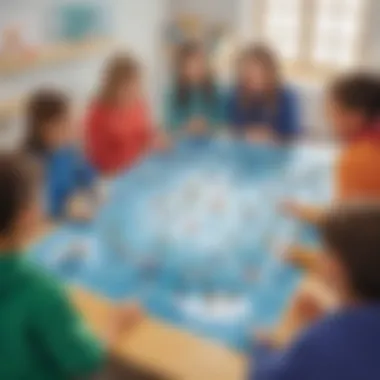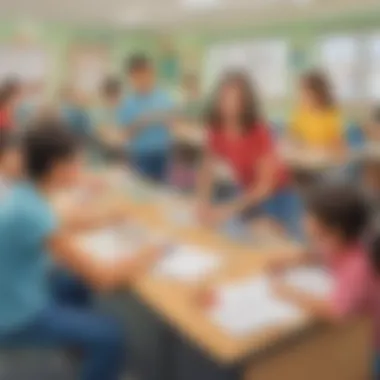Enhance Elementary School Ice Breakers for Engaging Educational Experiences


Creative Activities
In the realm of elementary school ice breakers, creative activities play a pivotal role in setting the tone for a dynamic and engaging learning environment. These activities not only foster a sense of collaboration but also stimulate the young minds towards exploration and innovation. Introducing craft ideas that are both captivating and educational can spark students' interest and creativity. Simple yet stimulating craft projects, such as DIY pencil toppers or origami bookmarks, can offer a hands-on experience that encourages fine motor skills and artistic expression. Step-by-step guides accompanying these activities are essential to ensure clarity and promote independent learning. By providing detailed instructions, educators empower students to follow along and uncover their creative potential. Moreover, discussing the educational value embedded within these activities is paramount. Reflecting on how crafting projects promote problem-solving skills, patience, and attention to detail unveils the hidden educational benefits that lie beneath the surface.
Fun Quizzes
Quizzes, a popular tool in the educational landscape, can be transformed into engaging ice breakers for elementary school students. By selecting quiz topics that align with the academic syllabus while infusing elements of fun and intrigue, educators can captivate young learners' attention and enhance their knowledge retention. From history trivia to mathematical puzzles, the diverse array of quiz topics available on platforms like ElemFun ensures that students encounter a stimulating and comprehensive learning experience. Varying question types, including multiple-choice, true or false, and fill-in-the-blank, cater to different learning styles and reinforce critical thinking skills. Through interactive quizzes, knowledge reinforcement becomes a natural byproduct. By revisiting key concepts through quiz sessions, students solidify their understanding and build a strong foundation for future learning endeavours.
Fact-Based Articles
Diving into fact-based articles opens up a realm of knowledge exploration for elementary school students. Covering an extensive range of topics, from scientific phenomena to historical events, these articles combine factual information with engaging narratives to make learning both informative and enjoyable. Breaking down complex concepts into digestible chunks, these articles ensure easy comprehension for young readers, fostering a love for learning and curiosity. Complementing the articles with additional resources, such as related articles or external links, encourages further exploration and aids in expanding students' knowledge horizons. By providing a gateway to in-depth information, these fact-based articles serve as a cornerstone for nurturing young minds and instilling a thirst for knowledge.
Introduction
Defining Ice Breakers
Purpose of Ice Breakers
Ice breakers encompass a crucial element in fostering connections among students within the educational setting. Their primary role lies in breaking the initial barrier of unfamiliarity, allowing individuals to establish rapport and engage meaningfully with one another. The essence of the purpose of ice breakers emphasizes the facilitation of a welcoming atmosphere that nurtures inclusivity and camaraderie among students. This characteristic of ice breakers as a conduit for building interpersonal relationships sets them as a commendable choice for enhancing educational experiences. Despite their benefits, it is pivotal to acknowledge the unique feature of time sensitivity in ice breakers, as their effectiveness often hinges on timely implementation within the classroom.
Benefits of Ice Breakers in Education
The integration of ice breakers in the educational context brings forth numerous advantages that contribute to a holistic learning experience for students. One notable benefit is the enhancement of student engagement, as ice breakers invigorate participation and stimulate interest in the learning process. Additionally, ice breakers provide a platform for students to develop essential communication and social skills, essential for their academic and personal growth. While the benefits of incorporating ice breakers are undeniable, a key consideration lies in the need for thoughtful selection and adaptation of ice breaker activities to cater to the specific learning objectives and dynamics of the classroom.
Significance of Ice Breakers in Elementary Education
Creating a Positive Learning Environment
The creation of a positive learning environment through ice breakers plays a pivotal role in cultivating a supportive and conducive space for educational exploration. By fostering a positive environment, students are more likely to feel motivated, inspired, and at ease, thus facilitating effective learning experiences. The emphasis on creating a positive learning environment signifies its importance as a popular choice for educators seeking to optimize students' academic growth. Despite its advantages, an important consideration is recognizing that the maintenance of a positive environment requires consistent effort and awareness.
Promoting Social Interaction
Promoting social interaction through ice breakers serves as a catalyst for fostering interpersonal connections and developing crucial social skills among students. The key characteristic of promoting social interaction lies in encouraging collaborative engagement, enhancing teamwork, and nurturing empathy. This emphasis on social interaction emerges as a beneficial choice for educators aiming to nurture well-rounded individuals beyond academic achievements. It's essential to note that while promoting social interaction through ice breakers offers myriad advantages, careful planning and execution are paramount for successful outcomes.
Enhancing Classroom Dynamics
Enhancing classroom dynamics through the strategic implementation of ice breakers contributes significantly to creating a vibrant and interactive learning space. The key characteristic of enhancing classroom dynamics revolves around promoting active participation, fostering creativity, and establishing a sense of belonging among students. This emphasis on enhancing classroom dynamics emerges as a popular choice for educators aiming to transcend traditional teaching methodologies and cultivate a dynamic academic environment. Despite its advantages, educators must be mindful of potential challenges in effectively managing classroom dynamics during ice breaker activities.


Overview of Article
Exploring Various Ice Breaker Activities
Delving into a diverse range of ice breaker activities allows educators to explore innovative strategies for promoting student engagement and stimulating creativity within the classroom. The key characteristic of exploring various ice breaker activities lies in the opportunity to cater to diverse learning preferences, ensuring inclusivity and participation among students. This emphasis on exploring a variety of activities emerges as a beneficial choice for educators seeking to encompass a broad spectrum of learning styles and interests. While the advantages of exploring various ice breaker activities are evident, careful consideration is necessary to align these activities with educational goals and student needs.
Tips for Implementing Effective Ice Breakers
Offering insights into the effective implementation of ice breakers equips educators with valuable strategies to maximize the impact of these activities on student engagement and learning outcomes. The key characteristic of tips for implementing effective ice breakers rests in the emphasis on setting clear objectives, considering student preferences, and fostering a supportive learning environment. This focus on practical tips for implementation emerges as a popular choice for educators striving to optimize the educational experiences of their students. Despite the advantages of these tips, educators must remain adaptable and open to refining their approach based on classroom dynamics and feedback for enhanced effectiveness.
Understanding the Importance of Ice Breaker Activities
Exploring the importance of ice breaker activities within the realm of elementary school education is crucial for nurturing a conducive learning atmosphere. Ice breakers serve as vital tools for establishing a positive and inclusive environment for young students. By delving into creative and captivating ice breakers, educators can lay the foundation for fostering connections, enhancing communication skills, and elevating overall classroom dynamics. This comprehensive guide aims to illuminate the significance of effective ice breaker activities tailored specifically to elementary school children while ensuring an enjoyable and interactive learning journey.
Fostering Inclusivity and Connection
Diving into the realm of inclusivity and connection within ice breaker activities for elementary school students shines a light on the essence of building strong relationships among peers. Encouraging students to interact and engage with one another cultivates a sense of belonging within the classroom, fostering a harmonious learning environment. Emphasizing inclusivity through activities that promote shared experiences and mutual understanding is key to establishing a cohesive classroom dynamic. Within this article, we unravel the core elements of fostering inclusivity and connection through ice breaker activities, paving the way for meaningful interactions and collaborative learning opportunities.
Building Relationships among Students
Unveiling the intricacies of building relationships among students unveils the essence of fostering camaraderie and mutual respect. This specific aspect contributes significantly to the overarching goal of enhancing classroom dynamics by creating a supportive network among classmates. The key characteristic of building relationships lies in cultivating empathy and trust among students, making it a popular choice for educators aiming to promote a sense of community within their classrooms. The unique feature of building relationships among students lies in its ability to strengthen social bonds and encourage cooperation, albeit with challenges such as navigating diverse personality dynamics.
Creating a Sense of Belonging
Delving into the realm of creating a sense of belonging sheds light on the importance of nurturing a supportive and inclusive classroom environment. This aspect significantly contributes to fostering a positive learning atmosphere where each student feels valued and accepted. The key characteristic of creating a sense of belonging revolves around promoting a culture of appreciation and inclusivity, making it a popular choice for cultivating a cohesive classroom community. The unique feature of creating a sense of belonging lies in its power to boost students' confidence and engagement, despite potential challenges related to balancing individual needs within a group setting.
Developing Communication Skills
Exploring the realm of developing communication skills through ice breaker activities illuminates the pathway to enhancing students' verbal expression and listening abilities. Embracing activities that encourage active participation and effective communication lays the groundwork for honing vital skills essential for academic and personal growth. Within this article, we delve into the core aspects of developing communication skills, aiming to equip students with the tools necessary for articulating thoughts and ideas effectively.
Encouraging Verbal Expression
The significance of encouraging verbal expression lies in fostering students' ability to articulate their thoughts and ideas coherently. This aspect contributes to the overall goal of enhancing communication skills by promoting vocal participation and self-expression. The key characteristic of encouraging verbal expression centers on empowering students to communicate confidently in various settings, making it a popular choice for educators seeking to nurture effective communicators. The unique feature of encouraging verbal expression lies in its capacity to boost students' self-esteem and public speaking capabilities, notwithstanding challenges related to encouraging active participation from all students.
Enhancing Listening Abilities
Delving into the realm of enhancing listening abilities unveils the essence of cultivating active listening skills among students. This aspect plays a pivotal role in fostering effective communication by promoting attentiveness and understanding during interactions. The key characteristic of enhancing listening abilities lies in fostering empathy and comprehension, making it a preferred choice for educators aiming to enhance students' overall communication proficiency. The unique feature of enhancing listening abilities lies in its capacity to improve students' retention and comprehension skills, despite challenges related to maintaining focus in a dynamic classroom environment.
Boosting Confidence and Comfort


Unpacking the significance of boosting confidence and comfort through ice breaker activities sheds light on the transformative impact of easing anxiety and fostering self-assurance among students. Creating a safe space for students to express themselves and engage with their peers fosters a culture of acceptance and empowerment. Within this article, we delve into the core aspects of boosting confidence and comfort, aiming to instill a sense of self-assurance and ease nervousness among elementary school children.
Easing Anxiety and Nervousness
Addressing the nuances of easing anxiety and nervousness illuminates the essence of promoting a supportive environment where students feel at ease to participate and express themselves comfortably. This aspect contributes significantly to building students' confidence and reducing performance-related stress in educational settings. The key characteristic of easing anxiety and nervousness lies in creating a low-pressure atmosphere that encourages students to engage actively with ice breaker activities, making it a beneficial choice for fostering emotional resilience. The unique feature of easing anxiety and nervousness lies in its potential to enhance students' ability to overcome challenges and setbacks, regardless of potential obstacles related to individual comfort zones.
Promoting Self-Assurance
Delving into the realm of promoting self-assurance unveils the significance of instilling a sense of confidence and optimism within students. This aspect plays a pivotal role in empowering students to embrace new experiences and interact with their peers in a positive light. The key characteristic of promoting self-assurance lies in fostering a growth mindset and nurturing resilience, making it a popular choice for educators aiming to cultivate a sense of empowerment among students. The unique feature of promoting self-assurance lies in its capacity to boost students' self-belief and adaptability, notwithstanding challenges related to addressing individual fears and insecurities within a classroom setting.
Creative Ice Breaker Activities for Elementary School Students
In the realm of elementary school education, the utilization of creative ice breaker activities holds a paramount significance as it sets the stage for establishing rapport among students, fostering communication skills, and enhancing overall classroom dynamics. By integrating innovative ice breakers specifically tailored for elementary school children, educators can create a vibrant and engaging learning environment that transcends traditional teaching methodologies. These activities not only promote inclusivity and connection but also boost confidence and comfort levels among students, nurturing a positive atmosphere conducive to effective learning experiences.
Name Game
Introducing Each Other Through Names
The practice of introducing each other through names serves as a fundamental building block in the process of fostering connections among students. By encouraging individuals to share their names and perhaps a brief description about themselves, this ice breaker creates a platform for students to initiate social interactions and form initial bonds. The simplicity yet efficacy of this activity lies in its ability to establish a basic level of acquaintance, paving the way for more profound engagement and collaboration throughout subsequent educational activities. While the name game may seem conventional, its foundational role in initiating communication channels should not be overlooked. Its unassuming nature lends itself well to the overall objective of creating a welcoming and inclusive atmosphere within the elementary school setting.
Fun Facts Sharing
Sharing Interesting Facts about Themselves
The activity of sharing interesting facts about themselves injects a layer of personalization and uniqueness into the ice breaking process. By offering students the opportunity to divulge intriguing tidbits about their lives or interests, this exercise not only helps individuals express their individuality but also serves as a catalyst for discovering commonalities among peers. This personalized approach fosters a sense of shared experiences and cultivates a deeper understanding among students, energizing the learning environment with a sense of curiosity and engagement. While sharing fun facts may appear lighthearted on the surface, its role in promoting social connections and expanding students' perspectives is invaluable to the overarching goal of enhancing educational experiences.
Collaborative Art Project
Creating Artwork Together
The collaborative art project stands out as a dynamic ice breaker activity that seamlessly merges creativity with teamwork. By engaging students in a collective artistic endeavor, this activity not only encourages cooperation and mutual respect but also stimulates the imagination and creative faculties of young minds. Through the process of creating artwork together, students learn to communicate ideas visually, negotiate differing opinions, and appreciate the diverse contributions of their peers. The collaborative art project goes beyond conventional ice breakers by fostering a deeper sense of synergy and interconnectedness among students, laying the groundwork for collaborative learning and collective expression within the classroom environment.
Storytelling Relay
Building a Collective Story
The storytelling relay offers a unique twist on traditional ice breaker activities by weaving a collaborative narrative thread among students. By collectively constructing a story relayed from one participant to the next, students not only exercise their creativity and improvisational skills but also learn the art of active listening and narrative cohesion. This activity challenges students to build upon each other's ideas, creating a cohesive storyline that reflects the collective imagination and wit of the group. The storytelling relay not only nurtures storytelling abilities but also strengthens students' camaraderie and mutual appreciation for each other's creative contributions, establishing a sense of collaborative storytelling prowess within the classroom setting.
Scavenger Hunt


Exploring and Solving Clues Together
The scavenger hunt emerges as a dynamic and interactive ice breaker activity that melds problem-solving with teamwork. By encouraging students to explore their surroundings, solve clues, and work together to accomplish a common goal, this activity promotes critical thinking, cooperation, and spatial awareness. The scavenger hunt not only challenges students' cognitive abilities but also instills a spirit of collaboration and camaraderie as participants navigate through a series of clues and challenges. This activity enriches the learning experience by fostering a sense of adventure, curiosity, and shared achievement among students, cultivating a positive and engaging classroom environment that nurtures both intellectual growth and social bonds.
Tips for Implementing Effective Ice Breakers in the Classroom
Ice breakers are crucial tools in setting the tone for interactive and engaging educational experiences in elementary school settings. By focusing on implementing effective ice breakers, educators can enhance student participation, foster communication skills, and create an inclusive environment that nurtures learning. Understanding the significance of ice breakers in the classroom is paramount to ensuring a successful learning environment.
When considering tips for implementing effective ice breakers in the classroom, it is essential to emphasize the importance of setting clear objectives. Defining specific learning goals for ice breakers provides a roadmap for both educators and students, guiding the overall purpose and outcomes of these activities. Clear objectives not only help in structuring the ice breaker session but also aid in measuring the success and impact of the activities on classroom dynamics.
Setting Clear Objectives
Defining Learning Goals for Ice Breakers
In the realm of implementing ice breakers, defining learning goals plays a pivotal role in shaping the educational experience for students. By outlining the objectives of ice breaker activities, educators can ensure that each session contributes meaningfully to the overall learning objectives of the classroom. Understanding the specific skills or knowledge that students are expected to gain through ice breakers allows educators to tailor activities that align with academic goals.
One key characteristic of defining learning goals for ice breakers is the ability to tailor these goals to the unique needs and dynamics of each classroom. Flexibility in goal setting enables educators to address various learning styles and challenges, providing a personalized approach to engaging students through ice breaker activities. This adaptability enhances the relevance and effectiveness of ice breakers in meeting the diverse needs of elementary school students.
Considering the dynamic nature of classrooms, the unique feature of defining learning goals for ice breakers lies in its adaptability to different age groups and educational settings. Whether focusing on social skills development or subject-specific knowledge, setting clear objectives empowers educators to create tailored ice breaker activities that resonate with students and enhance their learning experiences.
Consider offering Student Preferences
Tailoring ice breaker activities to student interests is a strategic approach to increasing engagement and participation in the classroom. By considering the preferences and tastes of students, educators can design activities that resonate with their individual interests, making the learning experience more meaningful and enjoyable. Matching ice breaker activities with student preferences cultivates a sense of ownership and investment in the learning process.
One of the key characteristics of tailoring activities to student interests is the ability to create a connection between academic content and personal experiences. Integrating elements that appeal to students' interests, hobbies, or cultural backgrounds not only enhances engagement but also promotes a deeper understanding of the subject matter. This personalised approach fosters a sense of inclusivity and diversity within the classroom setting.
The unique feature of tailoring activities to student interests lies in its capacity to promote a sense of agency and autonomy among students. By allowing them to contribute ideas and preferences to ice breaker activities, educators empower students to take ownership of their learning journey, fostering a positive and collaborative learning environment that celebrates individuality and diverse perspectives.
Encouraging Participation and Involvement
Creating a safe and supportive environment is essential for fostering student participation and engagement in ice breaker activities. By prioritising inclusivity and respect, educators can create a classroom atmosphere where students feel comfortable sharing ideas, expressing themselves, and collaborating with their peers. Encouraging participation not only enhances student confidence but also strengthens social bonds and communication skills.
Conclusion
In considering the significance of ice breaker activities in enhancing elementary school educational experiences, it becomes evident that these tools play a crucial role in shaping a conducive learning environment for young learners. Ice breakers are not merely about breaking the ice but about setting the tone for collaboration, communication, and inclusivity within the classroom. By integrating innovative ice breakers effectively, educators can initiate lasting connections, cultivate essential communication skills, and boost overall classroom dynamics. The emphasis on embracing innovative ice breakers lies in the transformative impact they have on student engagement and participation. Through thoughtful consideration and intentional implementation of such activities, educators can enhance the overall educational journey of elementary students, paving the way for a more interactive and enriching classroom experience.
Embracing Innovative Ice Breakers
Enhancing Educational Experiences for Elementary Students
One of the key components of enhancing educational experiences for elementary students through ice breakers is the fostering of creativity and critical thinking skills. By engaging students in unique and thought-provoking activities, educators can stimulate their cognitive abilities and encourage out-of-the-box thinking. This approach not only enhances academic learning but also nurtures a deeper appreciation for diverse perspectives and problem-solving strategies. The integration of innovative ice breakers in the classroom setting serves as a catalyst for fostering a dynamic and interactive learning environment, where students are actively involved and motivated to explore new ideas and concepts.
Building Strong Relationships in the Classroom
Building strong relationships in the classroom is paramount to creating a supportive and inclusive learning environment for students. Ice breakers that focus on relationship-building not only help students connect with their peers but also foster a sense of belonging and collaboration within the classroom. By encouraging open communication and mutual respect through such activities, educators can lay the foundation for a positive social climate where students feel valued and understood. The unique feature of building strong relationships through ice breakers lies in its ability to transcend social barriers and create a sense of community among learners. While this approach enhances student interactions and cooperation, it may also pose challenges in terms of individual preferences and dynamics within the classroom setting.







